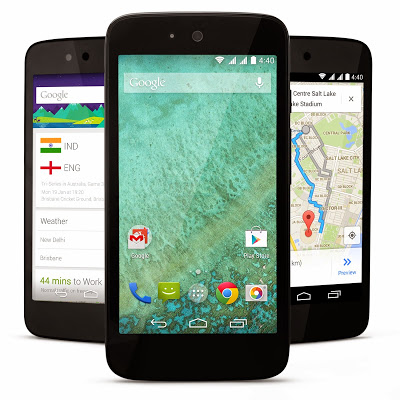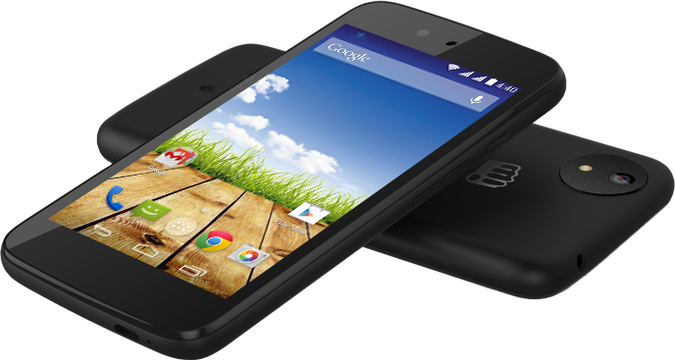Google Aims To Conquer "Next 5 Billion" With Android One Smartphones Starting At $105
Earlier this year at Google I/O, Google unveiled the Android One program, which is meant to help the "next 5 billion" non-smartphone users join the ranks of smartphone users for around $100 or less, while still enjoying a great experience and getting updates directly from Google. There are already Android smartphones that sell for $50 or less, but with Android One Google is trying to provide a certain level of users experience that it thinks all Android users should have.
Today, Google unveiled the first such phones, starting at only $105 (Rs 6399), from Indian manufacturers like Micromax, Karbonn and Spice and chip maker Mediatek. These companies are now beginning to sell smartphones which share certain hardware features such as a 4.5" screen, 1 GB of RAM, 5MP rear camera, 2MP front camera, dual-SIM slots, microSD support and FM radio.
The first batch of handsets from these three manufacturers also seems to use the same quad-core 1.3 GHz Mediatek processor (Cortex A7-based), although this is not part of the Android One requirements. More Android One phones will come later that will also include Qualcomm processors (perhaps even the recently announced LTE-capable Snapdragon 210 and Snapdragon 410 chips).
Google says it has partnered with carrier Airtel from India to upgrade these smartphones over the air for free in the next 6 months to the Android L version and whatever bug fixes may come after that. It's not clear from Google's announcement if the upgrades to Android One devices will completely stop after that period has passed, or if users could only get the updates over Wi-Fi for free as opposed to downloading them through the 3G network (will cost them typical data rates).
Google will also be offering 200 MB of data for free to all Android One customers, which can be used to download roughly 50 apps from the Play Store. These free data deals can help Indian customers use the Android One smartphones for something other than just making phone calls. This is part of the reason Google is also pushing for these low-end phones to have at least a 4.5" screen, whereas before we could see smartphones at such prices coming out with small 3.2" screens.
As we've recently learned, the bigger the screen, the more engaged the user becomes with the smartphone. That's good for customers, since they get more value out of their devices, but it's also good for Google because more people use more apps and visit more websites, which means advertising revenue for the company.
Google plans to expand the program to the Philippines and South Asia (Bangladesh, Nepal, Pakistan and Sri Lanka) by the end of 2014 as well as more countries next year. HTC, Asus, Acer, Panasonic and Lenovo will also be joining the program to make Android One handsets.
Get Tom's Hardware's best news and in-depth reviews, straight to your inbox.
Follow us @tomshardware, on Facebook and on Google+.
Lucian Armasu is a Contributing Writer for Tom's Hardware US. He covers software news and the issues surrounding privacy and security.
-
InvalidError Now we just need these things to get into NA - nowhere near as many inexpensive phones as I would like to see over here.Reply -
IInuyasha74 I just wish someone would release another phone with gaming controls like the Sony Erricson Xperia Play that I got 3 years ago and have thus far cannot upgrade to a new device because nothing else has this very important feature.Reply -
salgado18 ReplyI just wish someone would release another phone with gaming controls like the Sony Erricson Xperia Play that I got 3 years ago and have thus far cannot upgrade to a new device because nothing else has this very important feature.
It's not exactly the same, but you can get a bluetooth detachable joystick to use on a smartphone. It may not be as compatible as integrated hard keys, but at least you can upgrade the hardware and keep the keys. -
IInuyasha74 Reply14180225 said:I just wish someone would release another phone with gaming controls like the Sony Erricson Xperia Play that I got 3 years ago and have thus far cannot upgrade to a new device because nothing else has this very important feature.
It's not exactly the same, but you can get a bluetooth detachable joystick to use on a smartphone. It may not be as compatible as integrated hard keys, but at least you can upgrade the hardware and keep the keys.
Yea I know about this option. I fear that is the way I will have to go one day when I just really must get a new contract, at the moment I have been running without one since everywhere I am at has wifi. The bluetooth controllers might be the best option for me, but does suck to expand to having to carry two devices instead of just one phone. -
stridervm ReplyIInuyasha74 said:I just wish someone would release another phone with gaming controls like the Sony Erricson Xperia Play that I got 3 years ago and have thus far cannot upgrade to a new device because nothing else has this very important feature.
There is. It's called JXD S5800. Costs about $140. Just bought one. :)
http://www.jxd.hk/products.asp?id=645&selectclassid=009006 -
IInuyasha74 Reply14182667 said:IInuyasha74 said:I just wish someone would release another phone with gaming controls like the Sony Erricson Xperia Play that I got 3 years ago and have thus far cannot upgrade to a new device because nothing else has this very important feature.
There is. It's called JXD S5800. Costs about $140. Just bought one. :)
http://www.jxd.hk/products.asp?id=645&selectclassid=009006
Seen it, it has relatively poor controls, very large size, and highly prone to breaking down. Go searching online a bit you will find out that like 8 out of 10 die in the first 6 months. So enjoy it while you have it. -
amateurhour89 probably won't make it to the states.. reasons like the fda doesn't approve, or it won't pass emissions standards, lead paint, or... turn signals. i can see from here it doesn't have turn signals...... or all the money grubbing companies with $800 phones have their hands in every politicians pocket. could be that i guess too..Reply -
icemunk You can order these $99, or less quad-core mediatek cpu phones direct from China. I've ordered two so far; they work great. They're unlocked so you can use any carrierReply -
koss64 For those asking why you wont see these phones in the States, its because the market is more than content with paying $400-$1000 for a phone. The demands of Third World countries are cheap phones with 2 sim cards, decent sized screen and wifi. I feel sorry for MS right now as I doubt they can come up with a phone near $50(hell they haven't even made a Windows 8 phone with a keyboard...) .Reply

